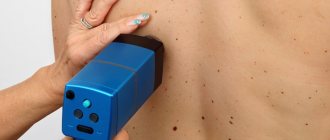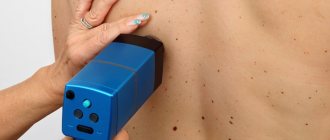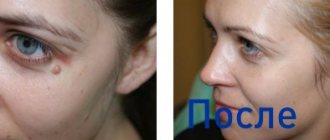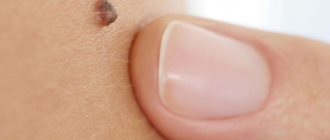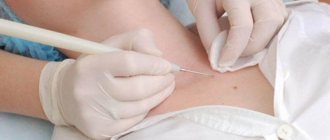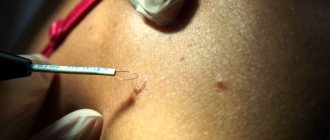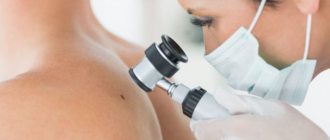From this article you will learn:
- What moles on the face “say”
- Why do they appear
- When is it necessary to remove moles on the face?
- What are the methods for removing moles?
- Why is it best to choose laser removal?
- Where are moles on the face removed in Moscow and how much does it cost?
The body of any person is distinguished by certain “marks”, which are known in everyday speech as moles, and in medicine they are called “nevi”. As a rule, a mole does not bother a person, but there are situations when it still needs to be removed. Such cases include situations when, for example, a mole is on the face, which, firstly, does not add an aesthetic component to the face, and, secondly, increases the risk of accidental skin injuries while washing or wiping with a towel.
Should moles be removed at all?
A mole needs to be removed only in two cases - if it causes physical or psychological discomfort. When a neoplasm is regularly injured during changing clothes or performing hygiene procedures, it is better to resolve the issue of removal for the sake of your safety. Moles on the face and other exposed parts of the body spoil the appearance and cause complexes and self-doubt. This problem especially worries young girls who always want to remain attractive and not think about how to disguise external defects. You should also remove moles that, without injury, have changed their shape and color, began to hurt and increase in size. It is advisable to remove moles that are located on the palms, soles of the feet, and scalp, where there is a high risk of injury. If you often go on seaside holidays, sunbathe a lot and have large moles on exposed areas of your body, you may want to consider removing them for your own safety. But only after consultation with a tumor removal specialist.
Features of surgical removal
Surgical removal of nevi has several advantages:
- the mole is removed forever - there is no risk of reappearance;
- the operation requires only one visit to the surgeon;
- minimum contraindications;
- possibility of histological study of tissues.
However, there are also disadvantages - the need for reliable local anesthesia, the likelihood of a mark/scar forming at the site of the removed mole, and a relatively longer recovery period.
Removal steps:
- Pain relief with local anesthetics.
- Excision of nevus within normal tissue.
- Stitches (if the mole is small, this may not be necessary).
- Application of a special bandage.
Sutures are removed on average on the 5th–7th day. The overall healing period ranges from 7 days to 21 days depending on the health condition. The surgeon will give recommendations on how to care for the postoperative area at home. You can go home immediately after the intervention. As a rule, only the use of antiseptic solutions is required. You can also come to the clinic for dressing changes.
The doctor sends the material obtained as a result of excision to the laboratory for histological examination. A laboratory assistant examines it under a microscope for any atypical structure. You will receive the results within a few days, and if suspicious cells are detected, the specialist will definitely refer you to a dermato-oncologist.
As a measure to prevent skin cancer, your doctor may recommend giving up tanning beds and reducing the time you spend in direct sunlight. It is necessary to use sunscreen with a suitable protection factor, do not drink alcohol in excess and do not smoke. Patients with a large number of moles may be advised to visit a dermatologist for preventive purposes once a year.
Examination of a mole before removal?
Before removing a nevus, it must be examined to exclude the malignant nature of the neoplasm (consultation with an oncologist, histology). Each mole that you want to remove on your own initiative should be at least visually examined. If the mole is on a hidden part of the body, small in size and completely small in size, you can simply observe it for a while. In any case, the decision to remove any skin growths should be made together with your doctor.
How is the removal done?
With laser intervention, the nevus is literally evaporated from the skin. The beam, aimed at pigment formation, evaporates cells layer by layer, partially affecting healthy tissue. Additionally, the laser acts on blood vessels, neutralizing bleeding.
The skin reacts normally to the intervention, cells begin to actively divide, filling the affected area with a layer of healthy epidermis.
Before the intervention, the patient is given local anesthesia. If a person is confident in his abilities, and the size of the formation is minimal, then he can do without pain relief. The operation itself lasts on average 5-10 minutes, depending on the size and specifics of the formation.
Where can you check moles in St. Petersburg for malignancy?
If you have a problematic mole and would like to have it checked for malignancy and removed, please contact our clinics. Removal of tumors is carried out by experienced specialists who treat each patient carefully and responsibly - dermatocosmetologist, dermatologist, laser removal specialist, dermatologist-oncologist. Moles are tested for malignancy in the laboratory immediately after collecting the material. If you decide to remove a mole at the nearest beauty salon, they will not provide you with this service, which means there will be no opportunity to assess the nature of the neoplasm, which is very important when diagnosing cancer. Laser mole removal can be done in our clinics.
General characteristics of formations
Moles are brown pigmented growths. They are formed as the human body grows and develops. Additional factors for the appearance of nevi are hormonal levels, exposure to ultraviolet radiation, and genetics. Each mole contains melanin, a complex pigment that is responsible not only for color, but also for protecting the skin from sunlight.
Content:
- General characteristics of formations
- Types of nevi
- In what cases is it necessary to remove a mole?
- Contraindications to the procedure
- What you need to know about laser surgery?
- How is the removal done?
- Recovery period
- Possible complications and side effects
Most moles on the human body are not dangerous. The main thing is not to injure them, use sun filters and regularly conduct self-examination. But some pigmented formations can degenerate into melanoma. This is a malignant tumor that develops from melanocyte cells.
Melanoma is characterized by a rapid growth rate (cells rapidly divide and launch metastases throughout the body). The result is damage to organs and systems, which leads to irreversible consequences and death.
Is it possible to avoid melanoma? Yes, it is enough to conduct a self-examination and visit a dermatologist if one of the moles is suspicious. The only caveat is that melanoma cannot be removed using a laser. For this purpose, only surgical excision is used. If you notice that one of your moles has changed in color, size, or structure, contact your dermatologist immediately.
How is mole histology performed?
Thanks to histological examination, cancer cells can be detected even at the stage of their inception.
Indications for mole histology:
- redness of the skin around the tumor;
- small ulcers on the surface of the nevus;
- burning or pain in the mole area;
- change in color, size, shape of the tumor.
Histology is performed with the procedure of surgical excision of the mole. A small tissue sample is removed and sent for further examination. In the laboratory, biological material is placed in a special suspension and examined under a microscope. Diagnosis is based on the analysis of pigment-forming cells - melanocytes. Laboratory testing may take up to 14 days.
Types of nevi
Benign skin formations can be congenital or acquired. Nevi are also distinguished by shade, size, shape and surface texture. Congenital moles are conventionally divided into 4 categories based on size: small, medium, large and giant. Giant moles are extremely rare and occupy the entire anatomical area (for example, the chest or face).
Giant moles carry a hidden threat. The risk of nevus degeneration into melanoma reaches 50%. Patients with giant nevi should be regularly examined by a dermatologist to monitor the process and prevent degeneration in time.
Acquired formations are formed in early childhood. At this time, there is an intensive movement of melanocyte cells from the depths to the surface of the skin.
The number and location of moles is determined by genetic factors, exposure to ultraviolet radiation and general health.
There are only three types of acquired nevi.
The first of them is epidermal. This is the accumulation of a large number of melanocytes in the epidermis (the upper layer of the skin), which triggers the process of development of a flat miniature mole.
The second type is intradermal. Indicates an accumulation of pigment cells in the dermis (deep layers of the skin), which form convex, voluminous nevi. The third variety is borderline. This is a cluster of melanocyte cells at the border of the dermis and epidermis.
Are there any restrictions after mole removal?
A small crust forms at the site of the mole, which, after complete drying, comes off on its own, leaving clean, healthy skin in its place. Under no circumstances should this process be accelerated, because an unsightly scar may form in place of the crust. You should not sunbathe for a month after removing a mole. Before going outside, if it is an open area of the body, use a cream with SPF 50+, which provides a good level of protection against ultraviolet rays.
Restrictions that must be followed for 2-3 weeks after mole removal:
- Avoid contact with water
- Refrain from visiting baths, saunas, swimming pools, and open water bodies.
- The place where the nevus used to be must be protected from any thermal effects.
- Both natural and artificial tanning in a solarium are prohibited.
Who is contraindicated for
Surgical removal of a nevus is contraindicated in the presence of the following diseases:
- exacerbation of chronic inflammatory diseases;
- infectious disease - viral, fungal, bacterial;
- fever of unknown origin, increased body temperature and other symptoms of intoxication.
Also, surgery may be postponed during pregnancy or breastfeeding - in each case, the doctor makes a decision taking into account the symptoms and condition of the formation.
Is it safe to remove moles?
Today you can often see offers to remove moles using the laser method in a cosmetology office. For safety reasons, this is absolutely not worth doing. To carry out high-quality nevus removal, you should contact specialized medical institutions, where the procedure is performed by experienced medical workers. It is possible to immediately send the material for histological examination. Beauty salons do not provide this service. If a mole is suspected of being oncological, it is not recommended to use the laser method, which does not allow taking a tissue sample.
If the technology is followed, the nevus removal procedure is absolutely safe. The laser acts locally only on tumors, without heating neighboring organs and tissues.
What you need to know about laser surgery?
Laser surgery is one of the methods of performing surgical procedures. It involves removing/cauterizing small areas on the human body. The advantage of the method is minimal damage to surrounding healthy tissue and rapid restoration of the epidermis. For different types of operations, a specific type and power of equipment is used.
Laser surgery is used to correct vision, remove tumors, remove blockages in arteries, and excise pigmented formations.
Care after mole removal
Within 10-14 days after laser removal of a mole, you should pay attention to your health and follow all doctor’s recommendations.
What not to do:
- Always cover the scab with a bandage or plaster - this can slow down the regeneration process.
- Expose the skin to heat - do not go to the bathhouse or sauna, sunbathe in the sun, or make warm compresses.
- Be in direct sunlight - even after the crust falls off, you must apply sunscreen before going outside (if it is a visible part of the body).
- Play sports - regardless of the location of the mole, it is necessary to exclude physical activity for 1-2 weeks.
- Take a hot bath - on the first day after the procedure, you should not wet the mole with water at all. Next, hygiene procedures must be performed with water at room temperature. The ideal option is a shower. When taking a bath, there is a risk that after steaming the protective crust will fall off and an unaesthetic scar will appear in its place. You should also not rub the mole with a washcloth.
If a mole has been removed from the surface of the palms or soles, any physical activity should be reduced as much as possible. To treat the damaged area, use only medications recommended by your doctor. If you notice swelling, redness or pain in the area where there used to be a mole, do not self-medicate, but immediately consult a doctor.
Doctor's comment
Every person has pigment spots on their body. The risk of injury or change in the appearance of moles is an indication for their removal. Today there are different ways to remove such formations: destruction using laser, high temperatures, chemicals, as well as surgical excision of the nevus. To choose the method that is most suitable for you, you need to make an appointment with a doctor. Treatment tactics are prescribed taking into account the size of the formation and the presence of signs of malignancy, but for this you should undergo a painless examination. However, if you have moles, especially if they are located in the area of contact with parts of clothing, it is recommended to regularly undergo a dermatological examination; with the help of a simple and painless examination, you can promptly detect signs of malignancy of the nevus. In this case, timely treatment will avoid unwanted consequences. Thanks to the clinic’s equipment with modern equipment, we have the opportunity not only to carry out radical treatment, but also to achieve excellent cosmetic results.
Why is it better to perform surgical excision of a nevus at the Swiss University Hospital?
- We employ specialists with extensive experience, including doctors of the highest category, professors, associate professors, and candidates of medical sciences. If necessary, doctors of narrow specializations are involved in treatment: oncologists, plastic surgery specialists, etc.
- Every year, more than 5,000 patients with various pathologies, including skin diseases, consult our specialists.
- The clinic offers almost all existing modern methods of treating skin diseases in accordance with the traditions of leading European clinics. Each specialist knows more than 100 types of operations within his specialization.
- More than 120 operations are performed in our clinic annually; we guarantee excellent quality and strict adherence to medical technologies.
